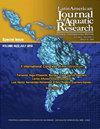Effect of dietary tryptophan on blood and plasma parameters of striped bass Morone saxatilis, exposed to acute stressors
IF 0.8
4区 农林科学
Q3 FISHERIES
Latin American Journal of Aquatic Research
Pub Date : 2022-08-31
DOI:10.3856/vol50-issue4-fulltext-2929
引用次数: 1
Abstract
Striped bass, Morone saxatilis, is a marine species that belongs to the Moronidae family, which has great recreational and commercial importance and high production potential for human consumption. This research examines two acute stress factors that can be frequent in fish production units: a) handling is carried out constantly due to maintenance needs, size separation, growth evaluation, and health state, and b) hypoxia likely occur as the culture tank biomass, temperature, and fish metabolic rate increase. Juvenile fish (initial body weight 200 ± 3.0 g) were distributed in 110 L tanks and fed one week with different dietary tryptophan (Trp) levels: CD0.5 (0.5%), D1.0 (1.0%), D1.5 (1.5%) and D2.0 (2.0%). The fish were then exposed to stress by handling (5 min) or hypoxia (45 min). After that, blood hematocrit (Hct), hemoglobin (HB) and plasma cortisol, glucose (GLU), lactate (LACT), total protein (TP), albumin (AL), and globulin (GLOB) were analyzed, and AL/GLOB ratio was calculated. All analyzed parameters showed great sensitivity to acute stressors. Hypoxia increased Hct, cortisol, and GLU and decreased HB and LACT. Handling decreased HB and TP and increased GLU and LACT. D1.0 and D1.5 prevented Hct and LACT disturbance. D1.5 Trp prevented HB disturbance. All Trp supplemented diets prevented GLU change under hypoxia and TP change after handling. The results suggest that Trp played a role in M. saxatilis homeostasis restoration under acute stress.色氨酸对暴露于急性应激源的条纹鲈鱼血液和血浆参数的影响
条纹鲈鱼(Morone saxatilis)是一种海洋物种,属于龙科,具有重要的娱乐和商业价值,对人类消费具有很高的生产潜力。这项研究考察了鱼类生产单位中经常出现的两个急性应激因素:a)由于维护需求、尺寸分离、生长评估和健康状态而不断进行处理,以及b)随着养殖池生物量、温度和鱼类代谢率的增加,可能会出现缺氧。幼鱼(初始体重200±3.0g)分布在110L的水槽中,用不同的色氨酸(Trp)水平喂养一周:CD0.5(0.5%)、D1.0(1.0%)、D1.5(1.5%)和D2.0(2.0%)。然后分析血红细胞压积(Hct)、血红蛋白(HB)和血浆皮质醇、葡萄糖(GLU)、乳酸(LACT)、总蛋白(TP)、白蛋白(AL)和球蛋白(GLOB),并计算AL/GLOB比率。所有分析的参数都显示出对急性应激源的高度敏感性。缺氧可增加Hct、皮质醇和GLU,降低HB和LACT。处理降低了HB和TP,增加了GLU和LACT。D1.0和D1.5防止了Hct和LACT干扰。D1.5 Trp防止HB干扰。所有添加Trp的日粮都能防止缺氧时GLU的变化和处理后TP的变化。结果表明,在急性应激条件下,Trp在沙氏M.saxatilis稳态恢复中发挥作用。
本文章由计算机程序翻译,如有差异,请以英文原文为准。
求助全文
约1分钟内获得全文
求助全文
来源期刊

Latin American Journal of Aquatic Research
FISHERIES-MARINE & FRESHWATER BIOLOGY
CiteScore
1.70
自引率
10.00%
发文量
44
审稿时长
4-8 weeks
期刊介绍:
Latin American Journal of Aquatic Research- LAJAR is the continuation of the journal Investigaciones Marinas (1970-2007) and is published since 2008 by the Escuela de Ciencias del Mar, Facultad de Ciencias del Mar y Geografía of the Pontificia Universidad Católica de Valparaíso. LAJAR is an “Open Access” journal that publishes in English language, original research articles, reviews and short communications on aquatic science, which contain the results of research conducted in aquaculture or in oceanic and coastal marine waters of Latin America.
The following topics are considered: Physical Oceanography, Chemical Oceanography, Marine Biogeochemistry, Marine Pollution and Toxicology, Marine Geology and Geophysics, Biological Oceanography, Fisheries and Aquaculture.
 求助内容:
求助内容: 应助结果提醒方式:
应助结果提醒方式:


